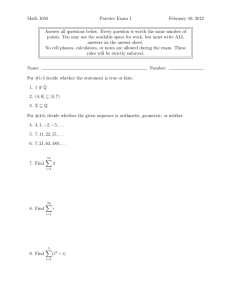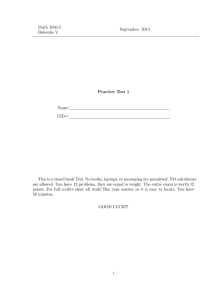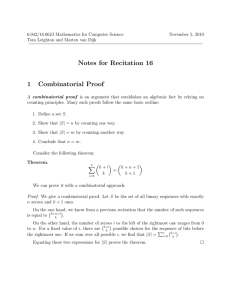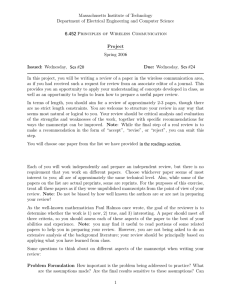Problems for Recitation 16
advertisement
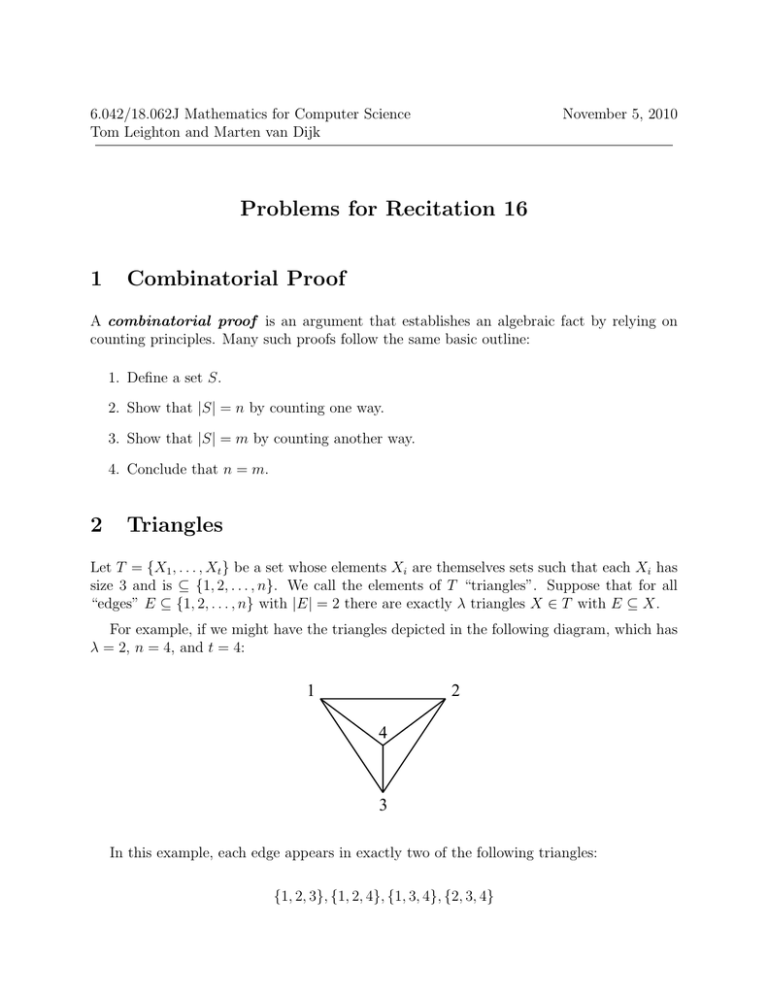
6.042/18.062J Mathematics for Computer Science
Tom Leighton and Marten van Dijk
November 5, 2010
Problems for Recitation 16
1
Combinatorial Proof
A combinatorial proof is an argument that establishes an algebraic fact by relying on
counting principles. Many such proofs follow the same basic outline:
1. Define a set S.
2. Show that |S| = n by counting one way.
3. Show that |S| = m by counting another way.
4. Conclude that n = m.
2
Triangles
Let T = {X1 , . . . , Xt } be a set whose elements Xi are themselves sets such that each Xi has
size 3 and is ⊆ {1, 2, . . . , n}. We call the elements of T “triangles”. Suppose that for all
“edges” E ⊆ {1, 2, . . . , n} with |E| = 2 there are exactly λ triangles X ∈ T with E ⊆ X.
For example, if we might have the triangles depicted in the following diagram, which has
λ = 2, n = 4, and t = 4:
1
2
4
3
In this example, each edge appears in exactly two of the following triangles:
{1, 2, 3}, {1, 2, 4}, {1, 3, 4}, {2, 3, 4}
Recitation 16
2
Prove
λ·
n(n − 1)
= 3t
2
by counting the set
C = {(E, X) : X ∈ T, E ⊆ X, |E| = 2}
in two different ways.
3
Counting, counting, counting
Learning to count takes practice! Briefly justify your answers to the following questions.
Not every problem can be solved with a cute formula; you may have to fall back on case
analysis, explicit enumeration, or ad hoc methods. Do as many problems as you can and
save the rest to study for Quiz II. You may leave factorials and binomial coefficients in your
answers.
1. How many different arrangements are there of the letters in BAN AN A?
2. How many different paths are there from point (0, 0, 0) to point (10, 20, 30) if every
step increments one coordinate and leaves the other two unchanged?
3. Find the number of 5-card hands with exactly three aces.
Recitation 16
3
4. Find the number of 5-card hands in which every suit appears at most twice.
5. There are 15 sidewalk squares in a row. Suppose that a ball is thrown down the row so
that it bounces on 0, 1, 2, or 3 distinct sidewalk squares. How many different throws
are possible? Two throws are considered to be equivalent if they bounce on the same
squares in a different order.
6. In how many different ways can the numbers shown on a red die, a green die, and a
blue die total up to 15? Assume that these are ordinary, 6-sided dice.
7. In how many ways can 20 indistinguishable pre-frosh be stored in four different crates
if each crate must contain an even number of pre-frosh?
8. How many paths are there from point (0, 0) to (50, 50) if every step increments one
coordinate and leaves the other unchanged and there are impassable boulders sitting
at points (10, 10) and (20, 20)?
9. In how many ways can the 180 students in 6.042 be divided into 36 groups of 5?
Recitation 16
4
10. In how many different ways can 10 indistinguishable balls be placed in four distinguish­
able boxes, such that every box gets 1, 2, 3, or 4 balls?
11. In how many different ways can Blockbuster arrange 64 copies of Cat in the Hat, 96
copies of Matrix Revolutions, and 1 copy of Amelie on 5 shelves?
4
There’s more than one way...
In the beginning of today’s recitation, we gave a combinatorial proof of the following theorem:
Theorem.
�
n �
�
k+i
i=0
k
�
=
�
k+n+1
k+1
We can also prove this theorem using induction. Give such a proof.
MIT OpenCourseWare
http://ocw.mit.edu
6.042J / 18.062J Mathematics for Computer Science
Fall 2010
For information about citing these materials or our Terms of Use, visit: http://ocw.mit.edu/terms.
